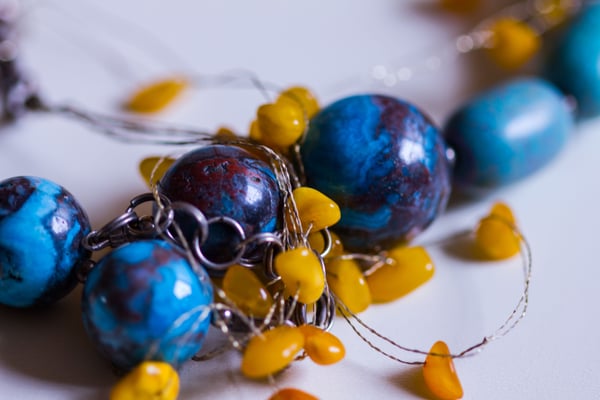A relationship is sometimes like a tangled necklace; we have difficulty understanding our partner or their perspective. Although in marriage, we commit to one another for better or for worse, we don't always know how to unravel the tangles we find ourselves in or the conflicts that confront us. Conflict resolution is uncomfortable and we can be all tied up in knots inside and unable to build a bridge between us.
Estimated reading time: 3 minutes
 Turn Conflict to Understanding and Compassion
Turn Conflict to Understanding and Compassion
This morning when reaching for a necklace, I found it tangled in my suitcase from a recent trip. Even though I didn't have time to untangle it, I began unraveling the necklace as if compelled. In that moment, I realized that I had been untying knots my whole life. In fact, to this day, I am the go-to person for knots.
I wondered why tangles engaged me with curiosity instead of frustration, which resulted in being successful 100% of the time. One of the biggest differences that surfaced was that I have certainty I can and will unravel every knot or tangle. Instead of causing frustration, tangles then become a joyous challenge—from tangle to tango. The success is not based on some special talent, acquired skill or even fortitude as much as on a mindset.
What would occur for couples if they looked at conflict as an invitation for closeness and understanding?
When we have this kind of a perspective, it changes the way we approach our partner. Instead of being frustrated with their behavior, we know on the other side of the conflict lies compassion, understanding, and connection. However, we need to build a bridge between differences to accomplish this outcome.
Whether it's a knot or tangle in a necklace, a garden hose or a love relationship, success boils down to a few simple, yet critical, mind shifts in wooing knots and tangles back to their native beauty.
Conflict Resolution: Accept the Invitation for Closeness
People often get frustrated when they unexpectedly stumble into a conflict. A person wants the experience to be different than it is. The denial of what's actually taking place sparks their own frustration.
For example, the other night, while I was working with a couple, the husband said, "I just think we should be able to communicate when one of us reacts, without days of pouting and punishing."
If they could, they would. Just like a knot in a shoestring or a necklace, it just is.
Just like a knot in a shoestring or a necklace, it just is.
That is simply the reality, for now, a knot. No amount of denying will make it different.
The man mentioned above may not have liked his wife giving him the silent treatment; nonetheless, she felt overwhelmed, and the survival brain was triggered. It is only through acceptance that we can begin to be empathetic to our partner and create a safe space that allows us to stay present to our hurt and choose to love.
When we have an expectation different than what is possible in the moment, our sense of frustration and failure blocks our ability to get about the business of changing our experience. We have our attention on what's wrong instead of what's possible. If we see a relationship spat (or tangle) as an opportunity to grow the relationship, the exchange can be an enjoyable adventure that brings us closer. It's up to us.
Steps to Regain Perspective and Connection in Relationship
STEP 1: Accept the reality of what is.
Relax and don't resist what is. You'll get back to a loving connection more easily and quickly.
When we resist what's happening, we're often not being present to our own or each other's feelings or pain.
STEP 2: Believe that it is possible to change.
It is always possible to grow and love each other better. Never give up on your partner or the potential of your relationship. Get support if you feel stuck. Sometimes a fresh perspective or a new EQ skill like empathy can make all the difference.
STEP 3: Shift your anger or frustration to curiosity and exploration.
In conflict, emotions can get tangled up inside and conflicting emotions can crash together. Before reacting, take some time to self-calm. Get in touch with what you love about your partner.
STEP 4: Get in touch with what you want in the relationship.
Perhaps it's closeness or respect for one another. In the scenario above, the couple might ask themselves, "How could we communicate differently when one of us gets triggered?"
Clarity of our vision for a loving relationship allows us to take steps toward it confidently.

STEP 5: Focus on the desired outcome.
We often keep our attention on the negative things in a relationship and neglect to get clear on what we want instead. Keep your attention on what you want and align your actions to match.
STEP 6: Discuss and agree on how you will handle a similar situation in the future.
After you've regained your balance and are connected in love, decide what to put in place next time to prevent the same mishap. For example, before you start arguing, you commit to both take space.
STEP 7: Play with creating the reality you want!
Ask what behaviors will match your love for one another? How can you be present to each other more lovingly? What do you want your relationship to look and feel like? Play with the possibilities of love!
Closing Thoughts
Believe it or not, every conflict gives you practice to build your patience muscles. Love is a choice: every interaction is an opportunity to cultivate greater understanding, shift your perspective, and create a stronger, more loving relationship!
The best marriage advice: learn and add tools to your relationship toolbox for a healthier and happier relationship. Be more emotionally intelligent in your relationship.
And when your relationship has some tangles, breathe deep and think of three things you love about your partner!
Related reading: "How to Talk to Someone with Empathy—and What to Avoid."
To learn conflict resolution skills or for support and new tools for successful relationship, try Heartmanity's marriage coaching programs.








